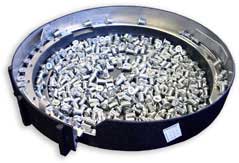Custom Tooled Vibratory Feeder Bowls
 The Art of Bowl Tooling
The Art of Bowl Tooling
Each time ADI looks at a custom vibratory feeding project, several people may be asked for their opinion on ways to orient a part. One person or technician designs engineered obstacles known as tooling. Others listen to and often implement suggestions from the people who install the bowl tooling. All of these people have learned over the years what to expect from parts under vibration.
ADI is eager to provide you with a quote on tooling, repairing or redesigning a stainless steel vibratory bowl. For more than five decades, ADI has applied the art of bowl fabrication and tooling. During that period of time, people have tried to make bowl tooling a predictable science. As of this date, no definitive work on bowl tooling exists. Trial and error is still a part of the tooling process.
Allow ADI to design your entire vibratory feeding application.
Tooled Vibratory Bowls
These bowls are typically integrated into complete Parts Feeding Systems. Visit this section for additional information and exemplary systems.
This vibratory feeder bowl is fabricated from stainless steel and lined with a protective coating to enhance durability and dampen sound levels. The line of feed is reduced to a single lane of travel and then 'hung' by its head and exits the bowl. The vibratory bowl will feed over 140 parts per minute.
This fabricated bowl consists of five tracks that collectively feed over 1600 parts per minute. The bowl feeder also serves as a sorter. Bullet primers are dumped into the bowl which occasionally contain excess parts that need to be removed prior to the assembly machine. The excess parts are removed from the bowl by discriminate tooling.
This pharmaceutical grade straight wall stainless steel vibratory bowl is designed to feed caps at the rate of 50 per minute. There are no air assists which greatly reduces vibratory feeder operational costs.
This stainless steel vibratory bowl features some of the most common tooling techniques found in feeding applications including a wiper, spill off, a hold down and a wrap-around track.
This feeder was constructed of dimpled stainless steel to reduce the coefficient of friction between the products it was feeding and the bowl's surface. This technique is commonly associated with feeding sticky parts while it also meets FDA requirements.
A straight wall stainless steel vibratory feeding bowl was best suited to feed this switch. The bowl is constructed of 12 gauge stainless steel. The number of track layers, which serve a storage function, is often determined by the amount of product needed on demand or feed rate.
The inner bottom of this bowl has been lined with rubber to reduce damage from impact. The track was lined with Brushlon ™ which serves multiple purposes; it provides a directional coefficient of friction as well as reduces noise levels.
This stainless steel bowl utilized dual tracks to reach required feed rates. The conveyor system is controlled by a series of sensors and moves on demand based on the needs of the assembly machine it feeds. A level control switch controls a hopper to maintain a consistent level of parts.
This stainless steel vibratory feeder bowl and tooling
View All Feeder Bowls Contact Us









